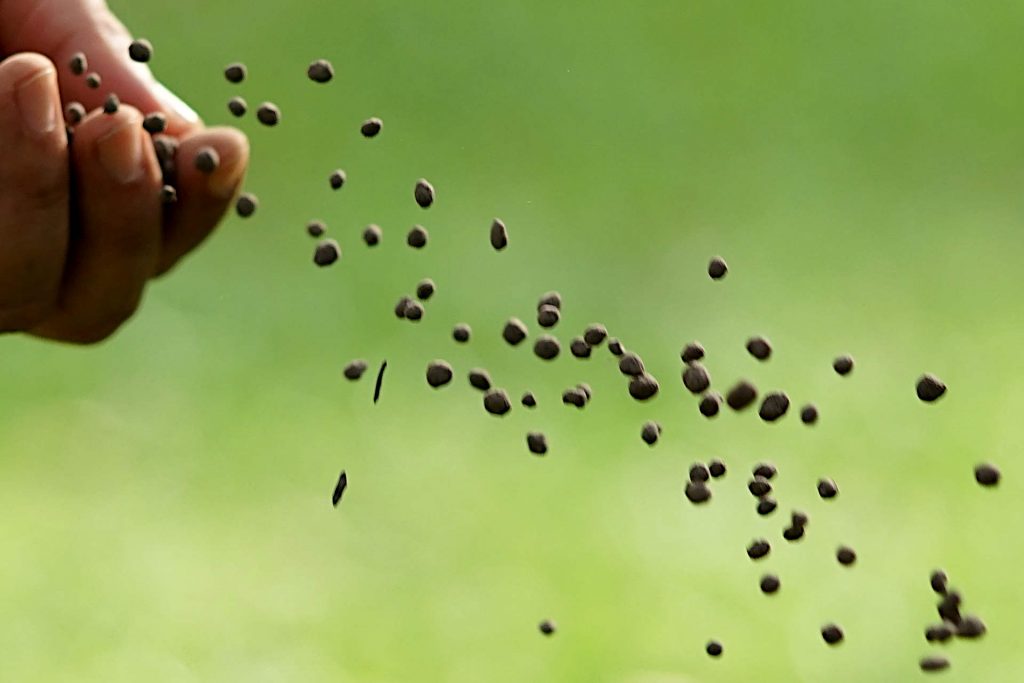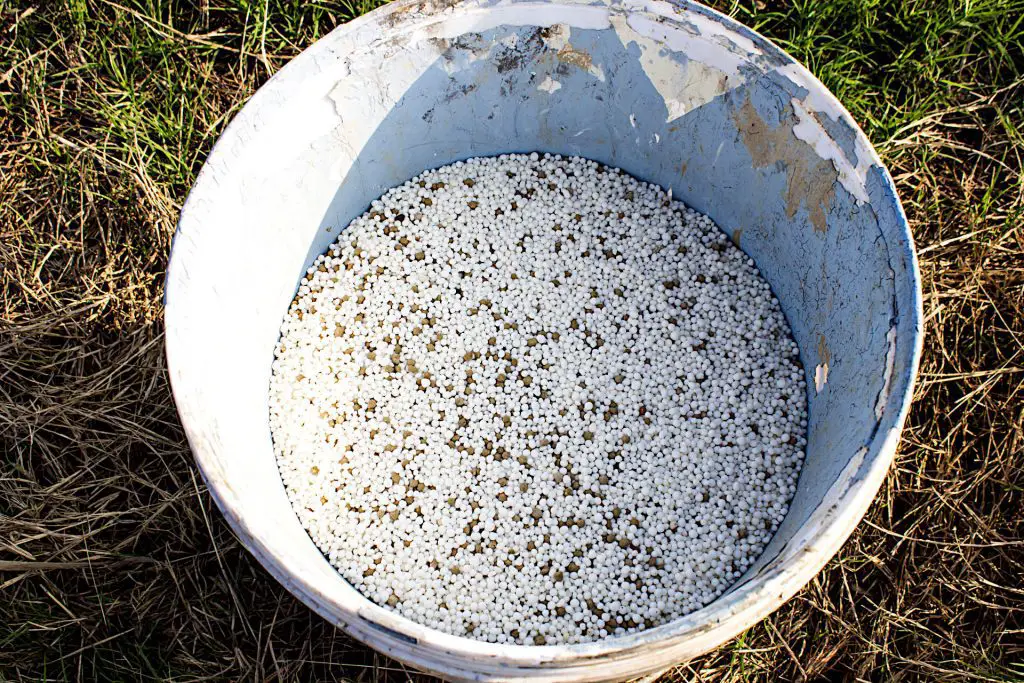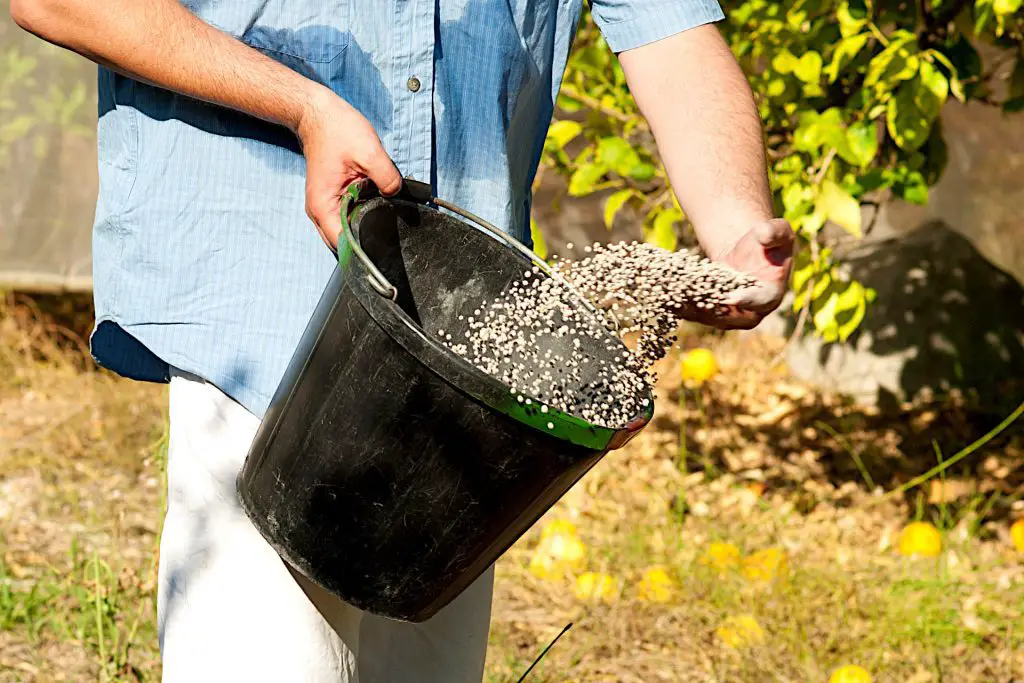How Long Does It Take for Granular Fertilizer to Dissolve
Granular fertilizers are the most common type of dry fertilizer (excluding compost) used by gardeners. They come in the form of small pellets which are designed to break down in the soil and feed plants with their required nutrients.
Unlike liquid fertilizers, because the pellets have to break down to allow the nutrients to be released into the soil, they work more slowly than their liquid counterparts. Depending on your use case this can be beneficial. However, it is important to understand how long it takes for granular fertilizer to dissolve and work, in order to get the most out of your fertilizer application.
Quick-release fertilizers are designed to have their nutrients exhausted in six to twelve weeks while a slow-release fertilizer can last in the soil for up to nine months. How effective these timescales are dependent on the granular fertilizers’ ability to dissolve. This is controlled by a number of factors such as moisture, climate, soil type, and fertilizer type.
How Granular Fertilizers Work

Fertilizers work by binding to available soil particles, slowly releasing their nutrients into the ground over time. Because of its interactions with the elements and organic matter in the soil, it eventually becomes a component of the soil reserve.
These fertilizers are compound fertilizers meaning they contain more than two of the principal nutrients required for plant growth, nitrogen, phosphorous, and potassium. This is commonly abbreviated to (NPK) a series of numbers that is usually displayed prominently on synthetic fertilizer bags.
The speed at which these nutrients are released is important. This is usually much slower with dry fertilizers than fertilizers in liquid form. Dry fertilizers, such as fertilizer in the granular form, need to break down first. This process can be affected by a number of factors such as particle size, climate, and moisture content.
Synthetic vs Organic
Organic and synthetic fertilizers are the two primary classifications of fertilizers. Organic fertilizers are those that are made from living organisms. When determining the kind of fertilizer to use you will need to think about the impact the fertilizer will have not just on the soil but also on the plant itself. Both organic and synthetic fertilizers include nutrients, but synthetic fertilizers allow for more precise control over the proportions of those nutrients.
Slow-Release vs Fast-Release Fertilizers
Beyond the question of organic or synthetic fertilizers, the next issue to consider is whether you will utilize a quick-release fertilizer (also commonly known as starter fertilizers) or a slow-release granular fertilizer.
Generally speaking, organic fertilizers are slow-release. There are some organic products such as fish emulsion (NPK 5-1-1) or burned egg shells (NPK 0-5-3) that can act more quickly.[1] The options with synthetic fertilizers are far broader with the chemical composition being formulated to be either quick or slow release.
The slow-release fertilizers will gradually release nutrients over an extended period of time, but quick-release fertilizers will dissolve fairly rapidly in the soil and supply nutrients within hours after application. This is the primary difference between the two types of fertilizers.
How Slow and Quick-Release Fertilizers Affect Lawns
The choice is going to come down to the growth stage of what you are planting. For example, with lawns, which make up the bulk of most gardeners’ fertilizer use, both types of fertilizers have the potential to be effective.
Quick-release fertilizers are often used with germinating grass seeds, which benefit from higher levels of nitrogen and phosphorous delivered quickly. This helps to establish good root growth and structure, and propel fast top growth. They can also used as an option for giving your lawn a quick boost.
On the other hand, established lawns benefit greatly from slow-release fertilizers with the grass able to grow more slowly without being stunted by the intense competition from weeds.
Synthetic Fertilizers
Synthetic fertilizers are usually compound fertilizers, that is they contain more than two of the principal nutrients, NPK. These are made from inorganic materials that are chemically formulated to create specific nutrient and macronutrient ratios to be more efficient for specific purposes and given applications.
They come in two types – soluble and insoluble. The vast majority are soluble, the main difference between the two is how quickly they dissolve into the ground, with insoluble fertilizers taking much longer.
Soluble granular fertilizers dissolve quickly, releasing nutrients into the soil over time. They can be formulated as either quick or slow-release, this control being one of the main advantages of soluble synthetic fertilizers. The disadvantage of soluble fertilizers is that they may not fully dissolve and release nutrients into the soil. This can lead to residue build-up on plant leaves and flowers. In addition, they have the propensity to easily leech into the groundwater.
Insoluble granular fertilizers, on the other hand, do not dissolve in water. They are generally phosphatic fertilizers and need acid to dissolve, so are recommended for use in acidic soils. They are slow-release by nature with the disadvantage being that they may get stuck in the soil if there is not enough acid and a lack of microbe activity. However, the advantage of insoluble synthetic fertilizer is that it doesn’t leech in the way in which soluble fertilizers can.
Deciding Which Option to Choose
The choice between the various different options of granular fertilizer is ultimately based on your needs and preferences. Non-dissolving synthetic fertilizers require certain soil conditions to work effectively and release their nutrients at a much slower rate
This helps in better plant growth as nutrients are delivered at the right time. Some synthetic granular fertilizer options combine both dissolving and non-dissolving properties for even faster nutrient uptake by plants. Ultimately, it all depends on your soil and what you want your plants to achieve – fast results or slow but steady growth throughout the season.
Organic Granular Fertilizer

Organic fertilizers can be any nutrient-rich material that comes from living organisms. This can be manure, compost, or products made from plant and animal by-products such as bone meal. They are insoluble and break down as a result of microbe activity in the soil. In commercial terms, excluding compost, when sold they are often pelletized in a similar way to synthetic fertilizers.
Organic Fertilizers Deliver Nutrients More Slowly
When it comes to organic fertilizers, there are a few things you need to keep in mind. Firstly, if you are keen on organic growing it is important to make sure the ingredients are all natural and free from harmful chemicals.
Being made from natural products, organic fertilizers depend on soil microbe activity to break down means that they work more slowly than most synthetic options. This results in a slower rate of absorption of nutrients by plants and a longer-lasting effect.
One of the key benefits of organic fertilizers is they that don’t only do they provide nutrients to the plants but they can also improve the soil structure and ecosystem.
In contrast, you have much more control over how fast synthetic fertilizer dissolve. Synthetic granules can be formulated to break down more quickly, this is why for certain application uses, such as germinating grass seed or when growing plants indoors, they are preferred. The smaller particle size also means that synthetic fertilizers get into the soil much easier than organic formulas do.
Fertilizer’s Absorption Rate: How Long does it Take?
When using fertilizer in granular form there are two elements that affect the length of time it takes from fertilizing to plant absorption. These are the time it takes to break down and allow the nutrients to be released into the soil and the time that plants take to take up the nutrients.
As granular fertilizers work best when they are absorbed into the soil over a period of time, the speed at which fertilizer is absorbed is key – too fast and it won’t be effective, while too slow and pests could become a problem.
Non-soluble fertilizers need to be soaked in water before use, while soluble ones can be used straight out of the bag. So, make sure to read the label carefully to see which type of fertilizer is best for your needs.
The key factors that affect how long it will take for the granules to break down are moisture and temperature, while soil, fertilizer make-up, and plant type will affect the nutrient take-up rates.
How Temperature Affects Solubility
Temperature affects the solubility of fertilizers with cold weather hindering the rate at which granules will dissolve. This happens because of increased molecular energy in the water as its temperature rises. The increased energy agitates and breaks down the fertilizer granules faster.
The result is that the absorption rate of the fertilizer increases as the air and ground temperature increase. This means that they will dissolve more quickly in warm water than in cold water. This can be important especially when looking to fertilize before winter.
Should You Add Fertilizer Before or After Rainfall

As we have just seen water is a key factor in absorption rates. When fertilizers hit the soil surface, water starts to break them down into smaller particles. Without moisture, soluble fertilizer won’t break down. However, you should avoid applying fertilizer if the grass blades themselves are wet, if there is standing water or if heavy rain is expected
Much will depend on your climatic conditions but combining your fertilizing with weather patterns can be helpful. The ideal scenario is if you can put down your fertilizer before moderate or light rainfall is expected in a few days or it has rained a day or so earlier and the grass blades have dried. If you live in more tropical climates, and experience short bouts of heavy rainfall, it is advisable to hold off. Heavy rain can wash away the fertilizer and may cause run-off pollution issues.
Soil Type and Plant Nutritional Uptake
A further factor that affects the fertilizer absorption time, is the rate of plant nutritional uptake. When fertilizers hit the soil surface, water or soil activity starts to break them down into smaller particles. This process can take some time depending on a variety of different factors.
Soil type plays an important role in how the nutrients get to the plant roots. Heavy clay compacted soils can be impenetrable for nutrients to get to the root zone. If your soil is like this you need to aerate the ground and improve drainage and nutrient access. Failure to do so can cause leaf burn and prevent your plants or grass being able to access the nutrients need to thrive.
When fertilizers reach the root zone, they need to be quickly absorbed by plants in order to provide them with the nutrients they so desperately need. If this doesn’t happen quickly enough, then these crucial substances will sit at the surface unabsorbed and unresolved – meaning that your plants won’t receive their intended benefits! This can often be the result of too much fertilizing.
Problems Caused by Fertilizers Not Dissolving
If your fertilizer is dissolving it will not be effective and your plants will not grow. Additionally, poorly dissolving fertilizer can result in elevated surface nitrogen levels causing possible pest infestations.
Fertilizers come in different grades, with the higher grade being more concentrated and therefore taking longer to dissolve. It is important to understand the numbers on the front of fertilizer bags. Too much fertilizing too much can harm your plants and lawn by strangling the growth.
Is it Necessary to Water after Fertilizing?
Usually, granular fertilizer does not need watering directly after application. However, this can be dependent on climate. In dry arid climates, you may need to water after allowing the fertilizer to settle.
Once the fertilizer has settled, watering as you would water your lawn or plants is normally enough to ensure there is enough moisture for the fertilizer to dissolve. If you do choose to add water more frequently, make sure it’s a light mist and avoid providing too much moisture at once.
Does Granular Fertilizer Wash Away?

It can be tricky to know when and which type of granular fertilizer to apply. There are a variety of products on the market that do not need water to break down, which are perfect for people who have trouble with water runoff or garden beds that flood easily.
The problem is that torrential rain or overzealous watering can cause the fertilizer you apply to be washed away before it has had time to dissolve or start to break down.
Other Options: Granular Vs. Liquid Fertilizer?
There are two main types of fertilizer: dry and liquid. Besides compost, dry fertilizers can be either powder fertilizers or granular fertilizers. Both work well when the plant needs nutrients delivered fast such as in early growth stages or over an extended period, up to six to nine months.
Liquid fertilizers release their nutrients more quickly than granular fertilizers, which is great for maintenance or when you want to see results quickly. They are far easier to use in terms of application providing more uniform coverage.
It’s important to choose the correct type of fertilizer for your plants based on their need and how fast you want it to work! For example, fertilizers will work faster if you liquid fertilizers but granular fertilizers provide longer feeding periods as they release nutrients over time.
Advantages and Disadvantages of Granular Fertilizer
| Advantages | Disadvantages |
|---|---|
| Dry | Bulkier takes up more room. |
| Cheaper, especially if bout in quantity or if looking for good organic options. | Require strict storage conditions to preserve in a usable state. |
| Longer lasting in the right conditions | The higher salt content can cause fertilizer burn on grass and plant leaves. |
| Slow or Quick Release | More difficult for immobile nutrients such as calcium, iron, sulfur, and boron to reach the root zone. |
| Soluble or insoluble options | More difficult to regulate in terms of nutrient access. |
| More efficient for pre-planting such as before sowing grass. | Slower delivery method |
| Choice in the method of application. It can be applied manually or with the use of a spreader. |
How Long Does Granular Fertilizer Last in Soil?

The length of the fertilizing effect on plants will depend on the type of fertilizer used, the purpose of the application, and the plant type. The most important fact is going to be whether you have used slow or quick-release fertilizers. Quick-release types will often have an effect from one to three months whereas slow-release fertilizers can last between six and nine months.
Summary: How Long Does It Take for Granular Fertilizer to Dissolve and Work?
As we have seen granular fertilizer is very flexible. There are various granular products that are available that can be used to control the timespan with which nutrients are delivered to your plants. fertilizer will last in soil form as short as a month to up to nine months, but will eventually degrade.
Granular fertilizers are usually an excellent choice. They provide you with more control. If the right fertilizer is applied in the correct way, with a proper schedule minimizes the risk of fertilizer build-up, you should have healthy thriving plants and effective control of weed growth.
Notes:
- Oregon State University: Here’s the scoop on chemical and organic fertilizers
